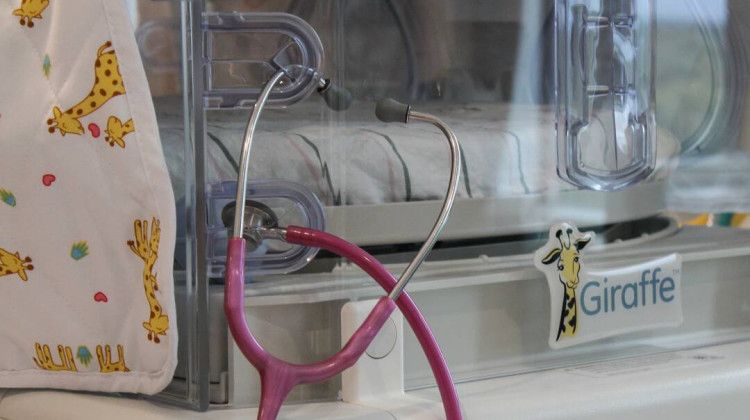
To control her seizures, Brandy Gibson had a part of her brain removed in January by Dr. Nicholas Barbaro. Photo courtesy IU Health.
INDIANAPOLIS -- When Brandy Gibson was 17 and pregnant with her daughter, Calie, something strange started happening when she opened the freezer door.
“I would just get the oddest feeling, and just would laugh and laugh,” she says. It felt like she had smoked marijuana.
When she shut the freezer, the feeling would go away. But it happened again and again during her pregnancy. Sometimes she would go to the freezer and open it up for fun, just because it felt so good.
“I just thought it was part of my pregnancy. I didn't think to go to a doctor,” she says.
The feeling went away completely after her daughter was born. But when she got pregnant again a couple years later, it came back. This time, things changed. It was triggered by the refrigerator now. And instead of the high feeling, she would black out, sometimes for a few seconds, sometimes for several minutes. “It was as if your body had a power button, and someone was pressing it and your batteries were just going dead,” she says. “Then all of a sudden, you're just gone.”
Brandy finally saw a doctor about her symptoms. She was diagnosed with epilepsy, and found out her strange feelings were actually seizures.
From there, Brandy started a medical journey that finally led her to letting a team of doctors operate on her brain in an effort to solve the problem. Along the way she struggled—as many people with epilepsy do—to maintain her normal life in the face of her increasingly disruptive symptoms.
Episodes of Electrical Activity
The typical image of someone having seizure on TV violent shaking or convulsing on the floor doesn’t apply to everyone with epilepsy. A seizure is an episode of increased electrical activity in the brain and those dramatic TV examples, known as tonic-clonic seizures, involve the whole brain.
But seizures can also involve just one part of the brain. These are known as partial seizures and they can be subtle, a momentary loss of consciousness or feeling of confusion, explains Meredith Runke, one of Brandy’s neurologists at the IU Health Neuroscience Center in Indianapolis.
“Usually there's something there structurally scar tissue, a developmental abnormality, a vascular malformation something there that's triggering the seizure disorder,” says Runke.
People having partial seizures, she says, may be unresponsive but their hands can be fidgeting or they can have unusual movements of the mouth.
That’s what they were like for Brandy. She usually didn’t fall to the floor, and in fact, most of the time when she lost consciousness, her body would keep moving, even talking. Sometimes she would smack her lips.
The doctors didn’t know this for sure at the time, but Brandy’s seizures were coming from her left temporal lobe, the part of the brain around the temple.
Temporal lobe epilepsy is the most common kind of partial seizure epilepsy, but Brandy’s case was unusual because her seizures were also reflex seizures, meaning they had a trigger: her fridge.
No one knows exactly why a fridge could trigger Brandy’s seizures, but one of the theories involved specific neurons in the temporal lobe called place cells, which are activated by a location.
The doctors think whenever she saw a refrigerator or even an image of one, it would remind Brandy of a location in her house, where her fridge is. In effect, she was recalling that place, even if she wasn’t actually there. Somehow this started a chain reaction in her temporal lobe that would lead to a seizure.
About 60 to 70 percent of people are able to control their seizures with medications. Brandy's doctors put her on medication, and again, the seizures went away after the pregnancy. But a couple years later, Brandy was driving her truck into town when she felt that familiar sensation again, like she was going to black out.
She pulled over. “And my mind shut off and I hit the gas and floored my truck into a dumpster,” she says.
Given what happened, she says she just knew she was pregnant again. Pregnancy, it turns out, was not the cause of her problems—she doesn’t have gestational epilepsy—but it seemed to make them worse.
This time they got a lot worse. She started having memory problems and she was even more sensitive to her trigger: the seizures would come if she just walked by the kitchen and glanced at the fridge. And after her son was born, the seizures didn’t stop.
A hidden disability
The trigger for Brandy’s seizures is really unusual, but the way epilepsy affected the rest of her life is not. For the 3 million Americans living with epilepsy, daily life can be hard to navigate. All kinds of every day activities are a danger if you might lose consciousness, says Runke. Driving, holding down a job, even taking care of your kids can become problems.
“I think what's really hard about it is how unpredictable seizures are,” Runke says.
In many states, people diagnosed with epilepsy lose the right to drive and have to be seizure-free for a long period of time before they can legally drive again. Runke says many of her patients have a hard time maintaining steady jobs, or are afraid to take care of their kids on their own. She said that her team loses about one patient a year due to drowning in a bathtub.
For a lot of people with epilepsy, this unpredictability can make them more vulnerable to stigma and economic hardship.
In the last several years several federal agencies have begun acknowledging this and are taking action. The Institutes of Medicine published a major 450-page report in 2012 pushing for increased data collection, better health care access for those with epilepsy, and improved education surrounding the condition. According to a 2014 report, the U.S. Department of Health and Human Services is trying to heed the IOM’s many recommendations.
The CDC has announced a round of funding coming in January 2016 for initiatives that improve the situation of epileptics: to increase the number of people with epilepsy getting appropriate medical care, to decrease stigma, and to improve their chances of holding down a job and completing school.
The challenges of living with epilepsy are made worse, Runke says, because epilepsy is also associated with other impairments, such as depression, anxiety, memory problems, and other cognitive problems that can make it hard to sustain good jobs.
Life put on hold
For Brandy, these seizures triggered by such a common, everyday object made normal life nearly impossible. Sometimes, a seizure would start just from feeling the breeze in the refrigerated section at the grocery store.
“I could not help it,” she recalls. “My mind [was] thinking about a refrigerator.”
To prepare for a seizure, she only had one trick. “The safest thing to do is lay down, even if it's on the floor,” she says.
After she had a seizure at work, Brandy actually lost a factory job. She says the management considered her a liability, and rumors circulated that she was faking her condition or addicted to drugs.
Brandy’s biggest worry was taking care of her kids. Preparing food was one of the hardest things she had to do. “Being a single mother, you still have to open that fridge, and being alone with your children and going into a seizure, you don’t know what’s going to happen,” she says.
So it often meant going out to eat, often to a nearby Chinese restaurant. “They love my daughter,” she says. “They know why I always went there.”
She knew it wasn't the healthiest choice, but it was the safe option. She felt she could be a danger to her kids every time she opened the fridge.
There was a particular reason Brandy was extra sensitive to the risks to her kids, even more than other parents might be. Though it had nothing to do with her seizures, Brandy had already lost her elder son, Bryson.
He passed away while sleeping, most likely from asphyxiation, from spitting up and inhaling. “I just went and checked on him and knew he was gone,” she says. “He just was sleeping and passed away.”
She had her youngest son, Vallis, about two years ago. Since her seizures kept happening after her pregnancy with him, she worried she’d fall into a seizure and hurt him somehow. So she sent him to live with his grandmother, and visited him there.
“I wasn't losing a child from something I do during a seizure. I had already lost a child,” she says.
Throughout this time, she was dealing with a lot of fear and grief and her friends just didn’t really seem to get how hard epilepsy was for her, and gradually fell out of touch.
“A lot of people just didn’t see what I truly went through,” she says.
A bold surgery
Since medications were not doing much to stop her seizures, Brandy came to Indianapolis and saw Dr. Nicholas Barbaro, a neurosurgeon at the IU Health Neuroscience Center, and the rest of his team. After several tests and brain scans, Barbaro decided she was likely a good candidate for a type of brain surgery known as a temporary lobectomy.
But they had to do an initial procedure to pinpoint exactly where the seizures were starting: “We open a flap of skin, and then open a window in the bone to expose the brain,” Barbaro says.
They put electrodes on the surface of Brandy’s brain so they could observe her brain while she was seizing. To speed things up, Brandy Googled images of freezers on a tablet. Within moments she lost consciousness. Over the next few days, still with an opening in her skull, her medical team triggered seizure after seizure, caught it on video, and pinpointed their source.
The team recommended her for surgery, planning to cut out a piece of her temporal lobe a few centimeters in size. “A temporal lobe operation for epilepsy is the most common kind of epilepsy surgery," says Barbaro. "So through a lot of experience, we understand what part is safe to remove."
It was at this point that Brandy had to make a choice. She really wanted to stop the seizures. But she was scared—not about the actual surgery, but about something the doctors told her about the side effects: They said she might have problems with her memory afterwards.
Brandy feared that meant she would lose memories of her family. She thought she could rebuild relationships with her family members that were still alive, but worried especially about her memories of her son Bryson, who she couldn’t get to know again.
“Right then and there is when I wanted to change my mind,” she says. “I almost decided I didn't want the surgery, because there's the one person that wouldn't be there for me to talk to and to remember.”
Lying in that hospital bed, she had to make a choice, and she kept going back and forth. But then her daughter called her. “It was just right then that I realized, ‘I need to do this for my kids that I have now,’” she says.
The doctors went back in and worked for a few hours to cut out that part of her brain. When she woke up she was relieved that her worst fears had not come true: “One of the things that made me the happiest when I woke up from the surgery was Bryson was the first thing I thought of,” she says.
That was in January and today, things still aren't totally back to normal. Brandy had some short term memory issues before, and she says it's worse since the surgery. But the seizures that came from her refrigerator are completely gone. She can prepare food for her kids again. And sometimes she stands in front of the open refrigerator, just because she can. “I do love the fridge now,” she says with a laugh.
Brandy had been living with her mother, but now she’s ready to move out. She’s looking for a new place with her boyfriend and both of her kids.
“My life is a lot better now,” Brandy says.
This story comes from Sick, new podcast from Side Effects Public Media.
Jake Harper can be reached at jharper@wfyi.org or 317-614-0482. Follow @jkhrpr.
 DONATE
DONATE








 Support WFYI. We can't do it without you.
Support WFYI. We can't do it without you.